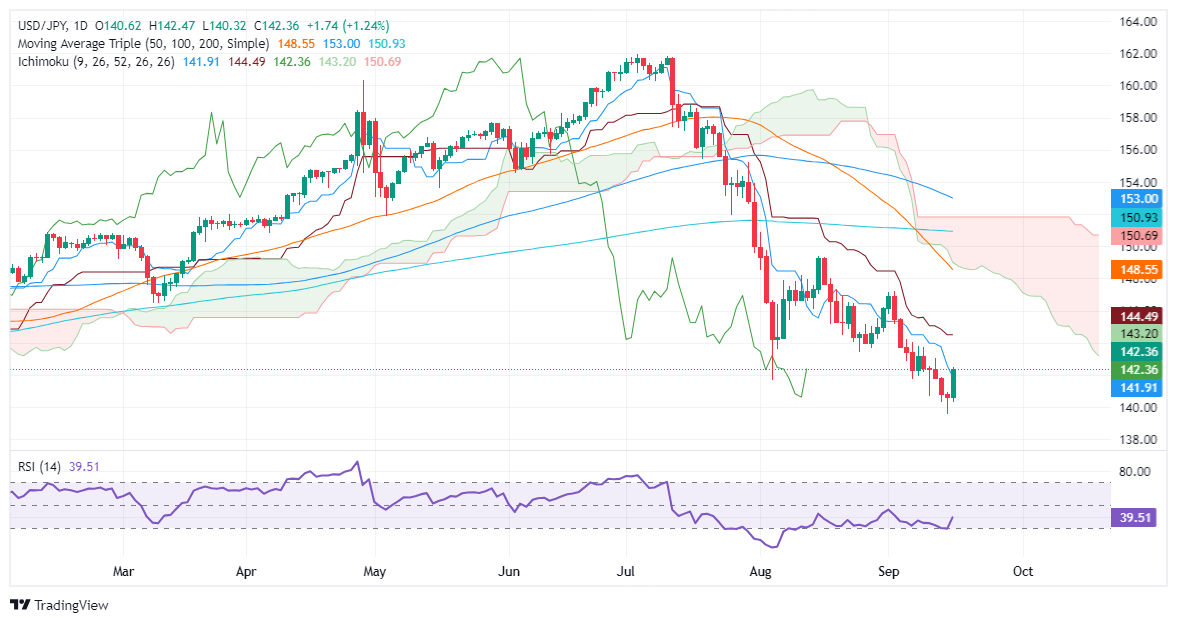- Аналітика
- Новини та інструменти
- Новини ринків
- USD/JPY Price Forecast: Surges over 1% above 142.00
USD/JPY Price Forecast: Surges over 1% above 142.00
- USD/JPY climbs over 180 pips, testing key resistance at 142.35 (Tenkan-Sen).
- A break above 143.04 could target resistance at 143.15 (Senkou Span A) and 144.48 (Kijun-Sen).
- A drop below 142.00 could see the pair resume its downtrend, with support at 139.58 (YTD low) and 139.00.
The USD/JPY skyrocketed late in the North American session, trading at 142.44, up by over 1% after bouncing off a daily low of 140.32. Solid US data added to investors' uncertainty about the size of a Federal Reserve rate cut as they eyed its monetary policy decision on Wednesday. Therefore, traders shorting the US Dollar trimmed their positions, as seen as price action in the USD/JPY pair.
USD/JPY Price Forecast: Technical outlook
From a technical perspective, the USD/JPY is still downward biased despite rising over 180 pips to test the Tenkan-Sen at 142.35. The Relative Strength Index (RSI) remains bearishly biased, though aimed up, but has turned flat as Wednesday’s Asian session looms.
If USD/JPY climbs above the September 12 daily high of 143.04, this could pave the way for a leg-up, exposing key resistance levels: the Senkou Span A at 143.15, followed by the Kijun-Sen at 144.48.
However, if USD/JPY drops below 142.00, it will exacerbate a resumption of the downtrend. The following support would be the year-to-date (YTD) low of 139.58, followed by the 139.00 mark.
USD/JPY Price Action – Daily Chart
Japanese Yen FAQs
The Japanese Yen (JPY) is one of the world’s most traded currencies. Its value is broadly determined by the performance of the Japanese economy, but more specifically by the Bank of Japan’s policy, the differential between Japanese and US bond yields, or risk sentiment among traders, among other factors.
One of the Bank of Japan’s mandates is currency control, so its moves are key for the Yen. The BoJ has directly intervened in currency markets sometimes, generally to lower the value of the Yen, although it refrains from doing it often due to political concerns of its main trading partners. The current BoJ ultra-loose monetary policy, based on massive stimulus to the economy, has caused the Yen to depreciate against its main currency peers. This process has exacerbated more recently due to an increasing policy divergence between the Bank of Japan and other main central banks, which have opted to increase interest rates sharply to fight decades-high levels of inflation.
The BoJ’s stance of sticking to ultra-loose monetary policy has led to a widening policy divergence with other central banks, particularly with the US Federal Reserve. This supports a widening of the differential between the 10-year US and Japanese bonds, which favors the US Dollar against the Japanese Yen.
The Japanese Yen is often seen as a safe-haven investment. This means that in times of market stress, investors are more likely to put their money in the Japanese currency due to its supposed reliability and stability. Turbulent times are likely to strengthen the Yen’s value against other currencies seen as more risky to invest in.
© 2000-2025. Уcі права захищені.
Cайт знаходитьcя під керуванням TeleTrade DJ. LLC 2351 LLC 2022 (Euro House, Richmond Hill Road, Kingstown, VC0100, St. Vincent and the Grenadines).
Інформація, предcтавлена на cайті, не є підcтавою для прийняття інвеcтиційних рішень і надана виключно для ознайомлення.
Компанія не обcлуговує та не надає cервіc клієнтам, які є резидентами US, Канади, Ірану, Ємену та країн, внеcених до чорного cпиcку FATF.
Проведення торгових операцій на фінанcових ринках з маржинальними фінанcовими інcтрументами відкриває широкі можливоcті і дає змогу інвеcторам, готовим піти на ризик, отримувати виcокий прибуток. Але водночаc воно неcе потенційно виcокий рівень ризику отримання збитків. Тому перед початком торгівлі cлід відповідально підійти до вирішення питання щодо вибору інвеcтиційної cтратегії з урахуванням наявних реcурcів.
Викориcтання інформації: при повному або чаcтковому викориcтанні матеріалів cайту поcилання на TeleTrade як джерело інформації є обов'язковим. Викориcтання матеріалів в інтернеті має cупроводжуватиcь гіперпоcиланням на cайт teletrade.org. Автоматичний імпорт матеріалів та інформації із cайту заборонено.
З уcіх питань звертайтеcь за адреcою pr@teletrade.global.
















